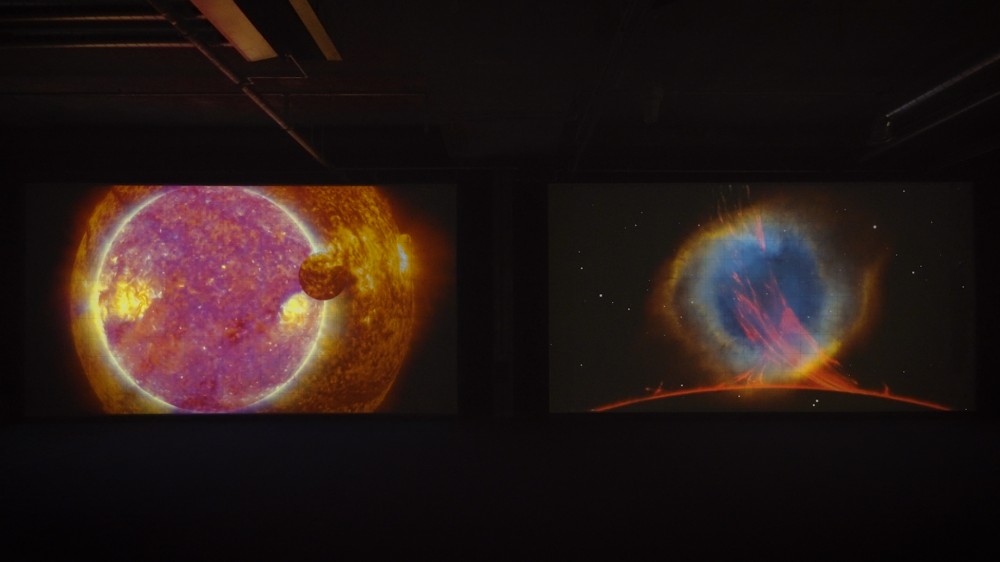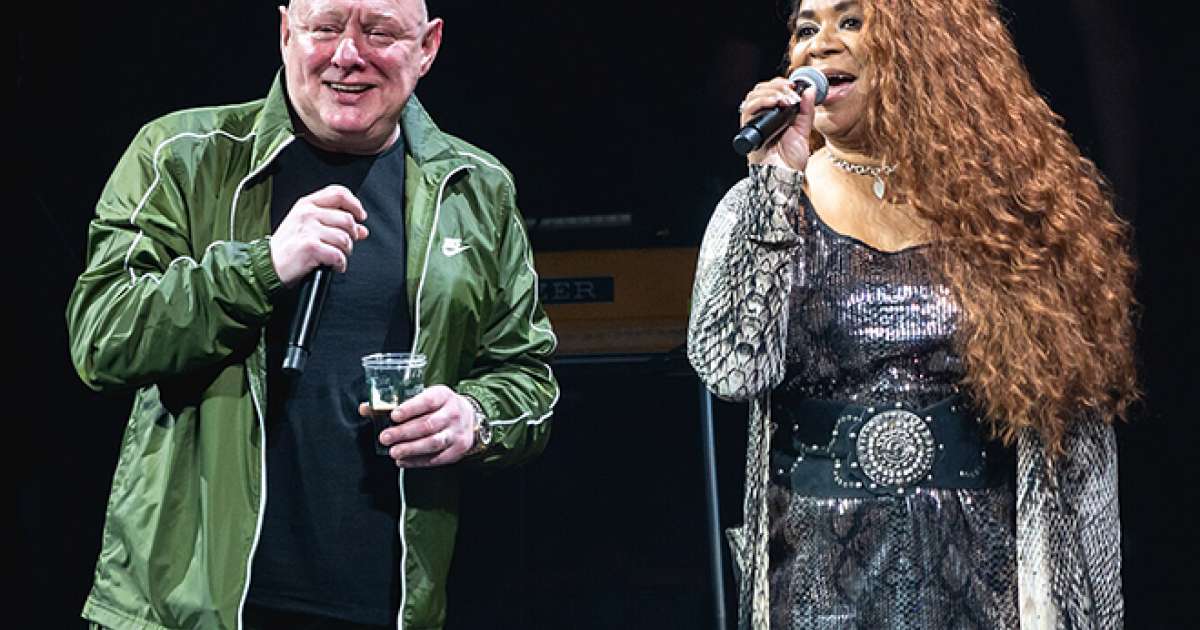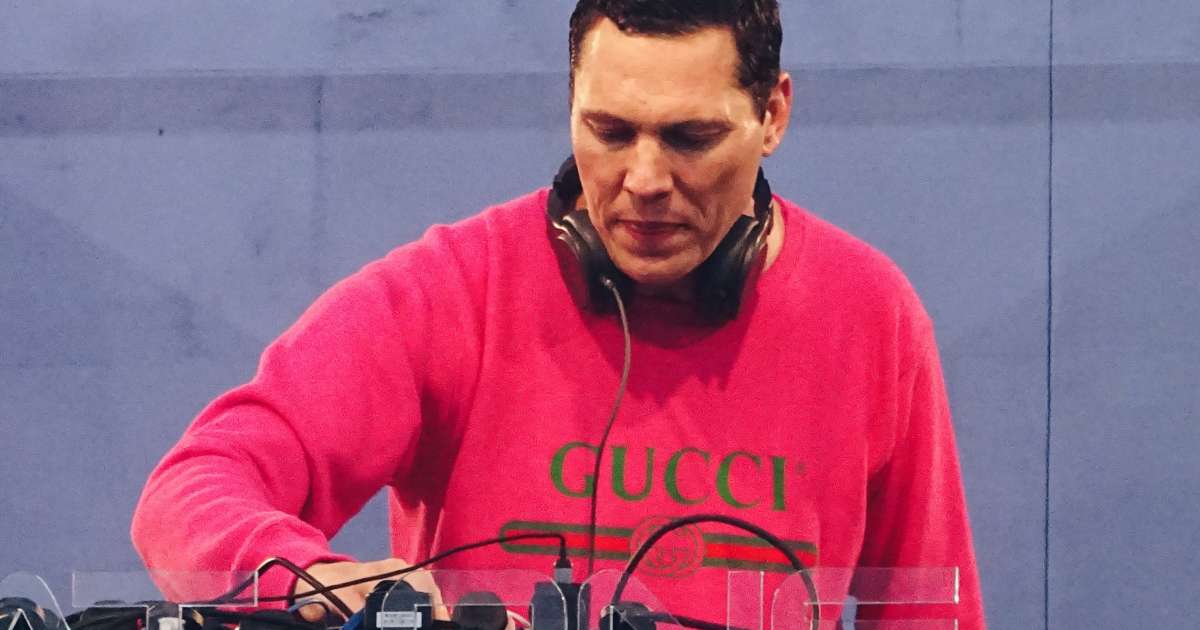
Fact Residency: Ryoji Ikeda
From the most simple sine wave to the most intricate data visualisation, Ryoji Ikeda understands his audiovisual art practice in explicitly musical terms.
“Music is beautiful because you can’t see it, and you can’t touch it, but everyone knows it,” he asserts. “You don’t need to have it explained, you don’t need special tools to understand it. You can charge it with meaning all by yourself.” Though the dizzying scope of the work featured in the artist’s current exhibition at 180 Studios extends from the coordinates of the known universe to the microscopic structure of a protein, the intellectual thrust of these installations and sound works is much less important than their emotional impact – how they make us feel. By situating his work in a liminal space, between the beautiful and the sublime, the quiet and the cacophonous, the one and the zero, Ikeda holds his audience in an intensely evocative environment, allowing us to charge his compositions with meaning on our own terms.
In the work we have explored over the course of his Fact Residency we have identified a dialogue between highly complex data-driven installations and simpler expressions with more sculptural focus. While divergent in their methods, each of these works represents an investigation into the building blocks of human life and the universe in which this life exists, propelled by the artist’s drive to simply “understand what nature is.” They also mark a shift away from a preoccupation with complex process towards a purity of vision and a clarity of purpose. “I don’t need to show techniques anymore,” says Ikeda. “It’s not about techniques, it’s more essential points.”
By bringing together these different facets of his practice in a single expansive orchestration, Ryoji Ikeda joins the dots between his nascent sound experiments to the most complete expression of the artist’s vision of “an aesthetics of data”. Understood as the repertoire a self-described composer, the signature of a Ryoji Ikeda composition becomes clear. With one ear tuned to the conceptual and the other to the physical, Ikeda composes for both your body and your mind.
Ryoji Ikeda Presents: test pattern
Existing in a lineage of radically minimal sound work that spans his early work with Japanese performance art collective Dumb Type, his ’90s albums +/- and 0°C and his subsequent releases on Raster-Noton, test pattern was borne out of the artist’s live show. “I needed visuals behind me when I DJ or do live performances, so I decided to show a binary expression of sound,” he explains. “A left-right visualisation of zeros and ones, black and white.” Despite the work’s simplicity, test pattern articulates some of the fundamental concepts and values inherent to the work of Ryoji Ikeda. By converting basic JPEGs or emails into binary code, the artist is able to recontextualize these fundamental components of digital life in their most basic forms via the “pure sonification of data”. Oscillating monochromatic patterns trigger extraterrestrial electronic tones that syncopate into the percussive pulse of a drum machine, approximating machinic minimal techno. In a sense, this is a work that would make just as much sense on the floor of a nightclub as it would a gallery space.
At its most musical, test pattern takes on a performative, almost theatrical presence, so much so that it is sometimes hard to believe that the patterns presented arise in totality from the ones and zeros of raw data. In this way, the work functions as a microcosm of Ikeda’s practice, allowing his audience to find rhythmic beauty in the infinitesimal sublime of data, an experience that can be simultaneously ecstatic and frightening. Observing the emergence of forms imbued with such strange physicality from flows of information beyond human comprehension can be jarring, something that is not lost on the artist. “Sometimes I push the sound level to the utmost limit to give a scary, overwhelming experience,” the artist explains. “That experience is not beautiful, so I call it sublime. Sublime experiences are a bit too much. There is fear and discomfort, as well as your own borderline between those feelings.” We find ourselves at this borderline with test pattern, caught in the balance between intensity and restraint, the one and the zero.
Ryoji Ikeda Presents: point of no return
Composing a delicate assemblage of basic shapes, sounds, light and shadow, the artist eschews the intricacies of data for a more sculptural approach. While gesturing towards the sublime, the infinite expanse of space and the immense, reality-warping gravitational force of a black hole, he focuses in on the beauty of the physical, bringing together a few simple elements to make sense of something unthinkably complex. Through his own artistic process of playing with space, the artist finds beauty in basic structures while drawing inspiration from the vast scope of the universal.
“point of no return is a very simple, very intense piece,” he says. “I paint a black circle on the wall and project light around it. This intensifies its blackness. I feel like it’s always firing, you get a bit scared and it becomes a bit overwhelming. The other side is the total reverse, just a white circle. It never changes, just stays still like a moon.” One of a number of works that Ikeda describes as “pretty much improvised”, point of no return was premiered at the Eye Filmmuseum in Amsterdam back in 2018 and saw the artist working within self-imposed parameters and responding to the physical space of the museum to create something original for the exhibition. “I wanted to have a new piece for my solo show there and I couldn’t think of anything,” he explains. “I didn’t even have any concept, I just played and experimented with a sketch and it was just completed in three nights.”
“A circle can represent infinity; it’s like a Platonic sphere, something very pure, like planets and stars,” he continues. “The ‘point of no return’ is actually a term used by astrophysicists, it’s like the event horizon of a black hole, the point at which you can’t escape its gravitational force.” The installation marks a movement away from the dense, data-driven works Ikeda is best known for, towards simpler conceptual works grounded in a sculptural materiality, revolving around structure and mechanism. Gesturing towards the most universal of themes while at the same time centering simplicity, point of no return presents a reified visualisation of the artist’s fascination with the cosmos.
Ryoji Ikeda Presents: data-verse
Ryoji Ikeda has been working with data for close to 16 years, collaborating with creative coders to develop an audiovisual language in order to explore what he terms “an aesthetics of data, information and computer science”. In many ways, the data-verse trilogy is Ikeda’s final word on this facet of his practice, a dazzlingly complex aesthetic investigation into the science of the natural world. The artist’s show at 180 The Strand features the world premiere of the third iteration of a work five years in the making, following data-verse 1, which premiered at the 58th International Art Exhibition, La Biennale de Venezia in 2019, and data-verse 2, unveiled in Tokyo Midtown, also in 2019. The show will mark the first time all three works will be shown simultaneously. “Three screens will be showing at the same time for the first time, and probably for the last time, so this is a really special occasion,” says the artist.
Commissioned by Audemars Piguet Contemporary in 2015, data-verse represents Ikeda’s crowning technical achievement, a dense visualization of tens of thousands of hours of rigorous scientific research and rhizomatic thinking, distilled into an intense burst of transcendent information exchange. “Data visualisation is really difficult,” admits Ikeda. “But the most essential important point is you have to understand the science first.” Working from vast data sets lifted from research conducted by NASA and the Human Genome Project, Ikeda folds DNA sequences, galactic coordinates, the structure of proteins, quantum physics and cosmology into the installations, parsing the raw data with self-written programs to be projected in three monolithic audiovisual presentations. The result is staggering, a perspective-altering reminder of the scale of the universe that verges on the psychedelic.
Ryoji Ikeda Presents: A [continuum]
To close out his Fact Residency, Ryoji Ikeda takes us back to his very first solo installation. Back in 2000 the artist debuted at the Hayward Gallery as part of Sonic Boom, a group show curated by sound artist and theorist David Toop that featured work from Brian Eno, Pan Sonic and Sonic Youth’s Lee Ranaldo. The work he showed, A, was a precursor to the immersive, sculptural version of the work he presents at 180 The Strand, fittingly titled A [continuum]. At that time, Ikeda lacked the confidence to present himself as the interdisciplinary artist he is today and admits being too shy to explain to Toop the full scientific and historical scope of the affectingly simple installation, a sonic exploration of concert pitch, A. Installing six speakers on the walls of a corridor in the gallery, Ikeda projected a variety of sine waves at the exhibition’s attendees, tones that, unbeknownst to Toop, were tuned to differing frequencies of A.
The work is a response to the historical variety of concert pitch over the past few hundred years. “During the ’70s the International Organisation for Standardisation fixed that A equals 440 Hz, but even contemporary orchestras never follow this,” explains Ikeda. He uses the example of two legendary tuning forks, which are also pitched at A, that of George Frideric Handel, which in 1751 was tuned at 422.5 Hz, and a tuning fork used by Steinway & Sons to tune pianos in London in 1879, which was tuned at 454.7 Hz. This variation inspired Ikeda to start collecting different pitches of A in classical contexts, a collection that now numbers into the hundreds. From these varying pitches of A Ikeda selected six frequencies to be emitted as sine waves simultaneously.
The result is a sound field that shifts as you move around within it, the superposition of different frequencies creating unique interference tones, resulting in what the artist describes as “invisible patterns of very complex sound fabrics and resonances.” 21 years later this simple sound work returns to London under a different guise. Assembling six towering Meyer Sound SB-1 Parabolic Sound Beam speakers, designed to throw low-distortion sound to the back rows of sprawling stadiums and themselves sculptural objects in their own right, Ikeda scales up the concept for A [continuum], the most fully realised iteration of the work.
This exhibition, produced and curated by The Vinyl Factory and Fact in collaboration with Audemars Piguet Contemporary, follows five years of collaboration between Ryoji Ikeda and The Vinyl Factory, which includes the UK premieres of Ikeda’s supersymmetry in 2015 and test pattern [N°12] in 2017, as well as several vinyl albums and new commissions. The exhibition presents 12 large-scale, multimedia works, six of which are premiering on the global stage, and five of which are showing for the first time in the UK.
The show runs until September 18. Tickets are available now at the 180 The Strand website. For more information about Ryoji Ikeda and his work, you can visit his website and follow him on Instagram.
All films directed and filmed by Pedro S. Küster
Additional Cinematography by Laima Leyton



